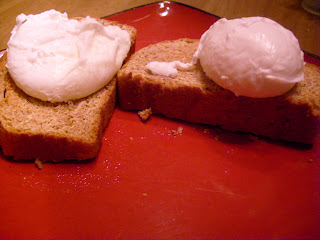I immediately ran for my book shelf and reached for my copy of Mastering the Art of French Cooking by the incomparable Julia Child! If anyone has the illustrations, easy to follow language, and clear and concise directions, it is her!
With 4 precious eggs left in the carton, I turned to page 116 and the first recipe of the Oeufs Chapter...Poached Eggs!
Below is Julia's recipe. The items you will need are bolded, the directions are in a normal font, and my notes and comments are italicized! I will tell you, Julia has gotten me several times with her recipes! True to my impatient form, I jump right into the cooking and generally do not take the time to read a recipe all of the way through. If you are going to try this, be sure to READ THE RECIPE THROUGH BEFORE STARTING!!! I have destroyed many-a-dinner by not doing that! :-X
Julia's Recipe is as follows
To transfer the egg from the shell to the water you may either break it directly into the water as described below, or break it into a saucer, tilt the saucer directly over the water, and slip the egg in.
You will need a saucepan or a skillet 8 to 10 inches in diameter and 2 1/2 to 3 inches deep, and vinegar (which helps the eggs to hold their shape).
Pour 2 inches of water into the pan or skillet and add 1 tablespoon of vinegar per quart of water. Bring to the simmer.
My brother and I went a few rounds on what constitutes simmering water. I though when the sides and bottom of the pan start to show bubbles and the water is steaming, it is ready. My brother, the biochemist, said just before boiling was where I needed the water to be. Fortunately, I heeded his advice, and he was right! I guess food and chemistry are more related than I would like them to be!
You will need 4 very fresh eggs, a wooden spoon or spatula, and a skimmer or slotted spoon.
Break one of the eggs, and, holding it as closely over the water as possible, let it fall in. Immediately and gently push the white over the yolk with a wooden spoon for 2 to 3 seconds. Maintain the water at the barest simmer and proceed with the other eggs in the same manner.
Since I was a first timer, I decided to work with one egg at a time. Each egg actually requires quite a bit of attention. I am sure after some practice and serious familiarity with the process I can learn to handle more than one egg at a time! I did take Julia's advice and used a saucer to get my egg in the pan with ease and less risk of breaking the yolk. The method worked swimmingly (pun intended)!
A bowl of cold water.
After 4 minutes, remove the first egg with the skimmer and test with your finger. The white should be set, the yolk still soft to the touch. Place the egg in the cold water; this washes off the vinegar and stops the cooking. Remove the rest of the eggs as they are done, and poach others in the same water if you are doing more. (*) The eggs may remain for several hours in cold water, or may be drained and refrigerated.
Ironically, I found this part to be the most difficult! My problem was getting a slotted spoon under the egg easily to remove it from the pan. They were lying just close enough to the bottom so that if I used any pressure to get the spoon under the egg, I would run the risk of breaking the yolk. I got a loose whirl pool going in the water, and then "caught" the egg with the slotted spoon. This method worked great for me!
A bowl of hot water containing 1 1/2 tsp of salt per quart and a clean towel.
To reheat the eggs, trim off any trailing bits of white with a knife. Place them in hot salted water for about half a minute to heat them through. Remove one at a time with a slotted spoon. Holding a folded towel under the spoon, roll the egg back and forth for a second to drain it, and it is ready to serve.
I skipped this step and set my poached eggs right on my hot wheat toast! In retrospect, I wish I had toasted some of the tomato basil wheat bread, but nonetheless, it was a delicious dinner! I made 2 eggs and had 2 successes!
 |
| An official member of the clean plate club! |


No comments:
Post a Comment